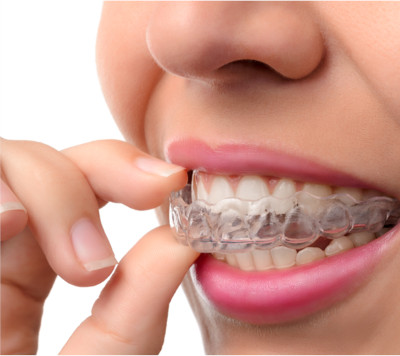Imagine wearing dental braces without anyone being able to tell. Clear aligners can help people with mild to moderate orthodontic dental problems do just that. How? Clear aligners rely on a different method for moving your teeth than traditional metal braces. Instead of a system of very visible brackets and archwires, clear aligners use a series of clear removable aligners. The goal of treatment is the same, though: to gradually move your teeth into the desired position.
The clear aligner invisible difference.
Invisalign® dental aligners are the most recognized brand of clear dental aligners but there are now more brands available. Newer brands like Smile Direct Club allow consumers to mail in their impressions rather than going directly to a dentist.
All clear aligners are almost invisible and look like clear plastic. The appliances are custom-made in a lab based on precise impressions your orthodontist makes of your teeth. Each aligner is worn 22 hours a day for about two weeks before moving on to the next. With each progressive aligner, your teeth move closer toward the ultimate goal. The average number of aligners worn during orthodontic dental treatment is between 18 and 30, depending on your specific case. Treatment time with dental aligners is usually about a year.
Advantages of clear aligners to traditional dental braces:
- Appearance — The aligners are clear and usually not noticeable to others.
- Comfort — The edges of removable braces are smooth, creating less irritation for your cheeks and gums.
- Convenience — The aligners can and should be removed when you eat and drink and when you brush and floss your teeth. Easier access to your teeth reduces your risk of tooth decay and periodontal disease, lessening your need for a tooth filling or gum disease treatment.
Clear aligners aren’t for everyone.
They are most effective for mild to moderate orthodontic problems. That’s because the aligners only move teeth horizontally and won’t be much help if your teeth turn in or out or are vertically challenged. Overcrowded teeth, widely spaced teeth or a severe malocclusion (bad bite) are better left to traditional dental braces, which provide for more control of teeth movement.
Clear aligners also require a lot of motivation. After all, they only work when you wear them. Invisalign dental aligners must be worn around the clock, minus time off for eating, drinking, brushing and flossing. That means you have to remember to put them back on after you take them off. If you wear them less than required, your teeth won’t move as quickly as planned. The result may be a longer course of treatment.
Clear dental aligners provide you with the convenience of removable braces that are hardly noticeable. This convenience comes at a higher price than traditional metal braces. If you are going to your dentist or orthodontist to get aligners, be sure to discuss payment options.
If you choose to wear clear aligners, you’ll be asked to see the dentist or orthodontist regularly to ensure the best success. Using an online / mail delivery service like Smile Direct Club requires online check ins with a licensed dental expert. Visits or check ins are less frequent than with traditional dental braces — about once every six weeks — but are necessary to track your progress and provide you with your next set of aligners.
Some basic rules still apply.
Since you can remove your dental braces to eat, you get the green light to enjoy hard and chewy foods. But you still need to practice good oral hygiene, brushing and flossing and regular dental visits twice a year. Don’t forget to keep your aligners clean, too! A dentist or orthodontist are the most qualified in determining the best treatment plan for you. If your case isn’t too severe, clear aligners might be an option.

